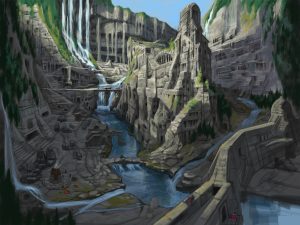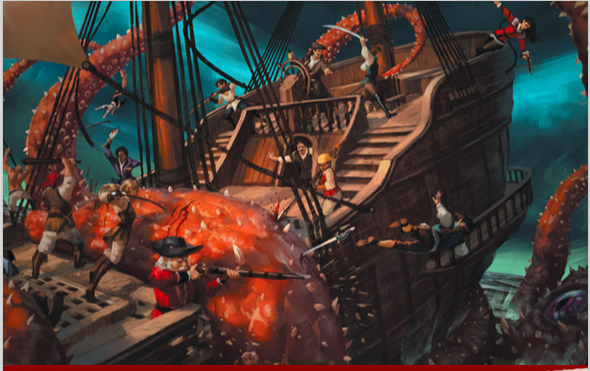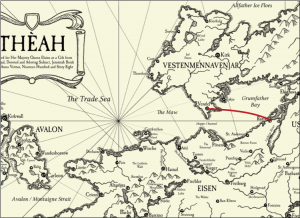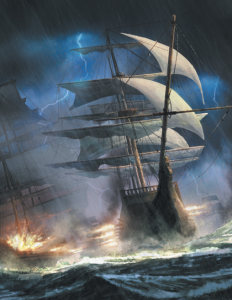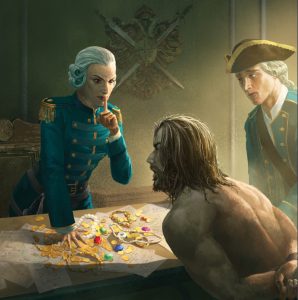 So, the preview for 7th Sea’s Pirate Nations book dropped a little while back, and I’ve actually written a ton about it that I’m not going to use because I don’t actually know what’s going to change between preview and release. Probably not a huge amount, but I want to be careful.
So, the preview for 7th Sea’s Pirate Nations book dropped a little while back, and I’ve actually written a ton about it that I’m not going to use because I don’t actually know what’s going to change between preview and release. Probably not a huge amount, but I want to be careful.
So instead I’m going to zoom out and talk a little bit about what’s in the book, and about why I’m pretty excited about it.
First off, thematically, this is two books. There’s no clear bright line in the text, but it’s pretty clear upon reading. The first, shorter book is supplemental to the setting of Theah, adding two location that are fairly proximate to Theah, Numa and La Bucca.
Numa, an analog for Greece is a collection of islands to the south-southwestish of Vodacce, that have been conquered many times but are currently free and working out what that means. It’s got all the element you need for game of Greek heroes, and if you squint your eyes a little, you can see Byzantium and Alexandria, so that’s cool. Still, this entry feels out of place in the Pirates book, and it’s a little hard for me to really speak to because it doesn’t scratch any particular itch for me, but I’m not sure it should get dinged for that (though there is some slightly creepy philosophy that I’m ok dinging it for).
In contrast, La Bucca‘s role in a pirate book absolutely makes sense. A former prison island for political prisoners across Theah, the prisoners seized the island mumblemumble years ago and now it’s a free port and erstwhile democracy. I had been a little leery about this one because in 1e, this island had been loaded up beyond usability with secret kings and the roots of idealized democracy. That has been mostly shed, and instead you get a really nice city that is well designed to be the home port for a pirate game. In fact, the city is fun enough that with a little elbow grease, you could make it the center point of play, Babylon 5 style, and that’s never a bad thing.
La Bucca is also somewhat transitional to the rest of the book, which covers the nations of the Atabean Sea, an analog for the Caribbean, also known as the Sea of Monsters. It’s a fun write up, full of color, but also with some cleverness as related to the many, many sea monsters. They are, in fact, the heart of commerce in the Atabean, with the hunting of monsters and the selling of parts providing motive for trade (and also, critically, providing expertise which helps even their footing with the Theans). There is absolutely trade with Theah out of the islands, but it’s constrained in ways that have kept the Nations of Theah from throwing their weight around too much, which is mostly good, but it has allowed for the rise of the Atabean Trade Company, which we’ll get to in a bit.
We also get to zoom in on three parts of the Atabean sea, the first of which is Aragosta, a sort of analog of Tortuga. It is also the most explicitly Pirates of the Caribbean inspired chapter of the book, and you can practically see the movie posters in the background. This is not a criticism. 🙂
I’ve got mixed feelings about this section. Part of it is really good – where La Bucca is a free port with rough edges, Aragosta is a full bore wretched hive of scum and villainy. It’s the birthplace of the brotherhood of the coast, has fun piratical color, dark supernatural bargains and all the other notes that might appeal. That’s the good. The less good is that this is the section of the book that indulges most strongly in telling it’s story rather than enabling me tell my story. A full 2 pages are dedicated to the tale of the guy who founded the bar where the city grew. More pages are dedicated to the secret fate of the pirate who signed the original Brotherhood of the Coast charter mumblemumble years ago and the curse than haunts them. None of it is bad, but it’s all someone else’s story.
The other nation, Jaragua, is an analogue of Haiti, and it deftly avoids becoming the car crash that I fear every time Haiti and RPG appear in the same sentence. Rather than steeping the whole thing in voodoo mysticism, the emphasis is on the impact of slavery and the aftermath of the recent revolution against it. It’s heavier fare than standard swashbuckling material, but it’s handled well enough that it feels like a different emphasis more than a total mismatch.
Aragosta and Jaragua have also both provided layups for the crown jewel of the book, the Atabean Trading Company. The basic idea is that because treaties keep the nations of Theah from operating too strongly in the Atabean, a villainous trade company has stepped into the gap and has killed, coerced, bribed or otherwise villained their way to the top. Functionally, they like an evil East India company (which is bad enough) with a Randian philosophy and a multi-level marketing scheme, which is to say they are amazing villains.
As a villain organization, they have very clear goals (making money) and equally clear villainy (Slavery, piracy, murder) to support those goals. That is to say, they don’t consider themselves villains – it’s just business, after all – which is exactly why they hang together so well. The ways in which they can be used in a game are so numerous and compelling that the biggest problem is coming up with a reason not to make them the centerpiece of your game. This is a delightful and ambitious write up, and it alone is worth the price of entry.
After the setting comes a character creation chapter, and it’s a little odd. It has all the information you need for new characters (new nationalities and backgrounds in particular) but also some information repeated from the corebook, which is odd. There are plenty of new advantages, with a few stand outs:
- There’s now a Letter of Marque advantage, which is thankfully only a point.
- Speed Load lets you reload a firearm in one raise rather than the usual 5. It costs a hero point, so that’s technically a check on it, but this makes me SUPER nervous (gun tricks are what killed 1e for me)
- Atabean Traveler is more interesting for it’s mechanic than it’s specifics, since it’s “Spend a Hero point to be able to ask a question about your environment” and I’m not sure that should need an advantage.
- The Ocean’s Favorite is basically “Would you like to be an awesome ship captain?” to which the answer is, of course, “yes”
- The Devil’s Due gets you a weird artifact as a result of your deal with the devil (or at least, Devil Jonah, one of those Pirates of the Caribbean type figures).
- Seeker of Soryana let’s Atabean natives visit the Isle of the Dead and recruit ghost allies. It’s interesting in that it’s like Skalds as a not-quite-sorcery
- Whisper to Mother is interesting mechanically because it’s a specific Porte trick that does not require Porte but does have very specific setting ties.
- My Word is My Bond is so fun that one of my players immediately started gunning for it. Make an oath, spend X hero points, and for the duration of the scene, gain X raises on every risk, so long as you’re working to fulfill your work.
- La Palabra made me laugh, since it’s an idea I first encountered in science fiction. If you have this advantage, you can secretly communicate to others who have it by embedding your messages in normal-seeming conversation.
There are also some new Arcana, which is great, but it going to give me even more Sorte headaches. There are also a ton of sample stories, which is a pretty useful reference.
There is also some new Sorcery, which fascinates me, since this may be the biggest deviation from the 1e model.
Charter Magic is an oddball since you don’t really buy ranks in it – it’s a blood ritual that a group engages in, signing the charter and spending a hero points. For every signatory (hero or villain), put a die on the charter – players can pick those up and ad them to any roll, with the pool refreshing at the beginning of the session. But if you break the charter, you’re cursed, which sucks.
This is a fun option with a heavy dose of metagame (and shades of some other John Wick designs), and I only wish there had been a sample charter or two here, but there are some later in the book.
Kap Sevi Is the inevitable voodoo, whose practitioners channel the “Lwa”. It’s explicitly tied to Ifiri (Africa analogue) via the slaves brought to Jaragua, and is explicitly a variation on those traditions as they were pushed though the brutality and horror of slavery.
Structurally, each rank of sorcery you buy lets know choose one Lwa you can channel, as well as 1 big power and 2 little powers (with power availability tied to which Lwa you know). In an interesting bit of color, the Lwa is summoned into the Sorcery and powered by offering of the self. Mechanically that means big powers are tied to the character’s virtue and little powers are tied to a quirk. While the power is in use, the Virtue or quirk are unavailable for use. I admit I’m not sure what that would look and feel like in play, but I’m curious to find out.
The other big limiter is that when summonng a Lwa, it remains in the Sorcerer until sunrise, so those are the only powers the sorcerer has access to for the duration, and you can only maintain one big and 2 little powers at a time.
The Lwa are, of course, named. There are 5 in the book and no reason there couldn’t be more. One one hand, this is great, because it means the magic is personified, which is always more fun to play. On the other hand, I admit, I’m a little bit unsure how I’m supposed to run this sort of magic. There are trappings that the sorcerer is supposed to engage with to appease the Lwa, but I don’t know what that means. Should it be a conversation with me as the GM taking the part of the Lwa, or am I just supposed to stand back and let it be an role playing opportunity for the character?
The powers themselves are interesting, varied, and in some cases very potent. Curiously, there are a lot of information-related powers, which I’m good with. Those tend to be very gameable, since taking them tells the GM what rocks to hide things under. Curiously, there is no actual ability to animate the dead, though there are numerous references to it happening.
Mystirios is Numan magic, so while cool, it seems out of place in the book. There’s a curious detail that the powers come from the human spirit and are merely inspired/revealed by the gods. This struck me because it very much seems to resonate with the 1e ideas behind the Knights of the Rose and Cross, so I’m curious if that thread will come up again.
Mechanically, you buy a rank in Sorcery and learn a particular god’s secret which has a big power that costs a HP to trigger and a little power that’s free after you’ve used the big power in the scene. It’s a weird mechanic, and it makes more sense for some gods than others. It’s a kind of fun idea though, since it has a built-in cadence.
One nice sidebar – there’s one villain-only Mystirio and it’s OH LORD NASTY. It makes me want to write up more villainous sorcery options.
Mohwoo is a weird one, because it has zero ties to the setting. I don’t know if that’s because it’s a teaser for something else in the world or if it’s just a crazy one off.
Anyway, terminology aside, and as we’re probably familiar with now, there are big powers and little powers. When you get a tattoo, you get a lot big and little power associated with that symbol, plus the little power from a different tattoo. When you buy a new rank (and get a new tattoo), you pick up two more powers, either major or minor, constrained by the symbols you bear.
So, for example, the Fish symbol’s minor power is “no need to breathe for the rest of the scene” and the major power is “Use the activation instead of spending a raise when swimming or in water”
One fun addition to this is that there’s a set of things that the GM can spend danger on when a Mohwoo is activated, and I love this. None of them are super nasty, but they’re colorful and fun and make the magic feel a little less predictable and rote. As with villainous sorcery, I kind of want to write up more of these for other types of sorcery.
A bunch of other mechanics are thrown in under Swords, Ships and Secrets. It explains how foreign duelists interact with the Duelist’s guild, and introduces 3 new styles – a machete style, a capoeira equivalent, and Spartan fighting.
We have more ship origins and abilities. At first glance they all seem more potent than the core set, but I’ll probably need to really look at those side by side. New ship backgrounds are fine, but the new adventures (Cheevos!) are probably the most welcome addition.
There are 2 new secret societies. La Cosca are the Robin Hood Mafia, and La Riroco are abolitionist monster hunters. Obviously, both are awesome.
There’s also a bit of space committed to the Pirate’s code and charters, which is made more useful for its direct tie into Charter magic. There are also two pages on how to talk like a pirate (arr).
There’s a chapter dedicated to sea monsters, and while it’s mostly color (because monster statblocks are pleasantly small) there are also a few new Monstrous Qualities, which are absolutely delightful.
Finally, there’s a chapter on running a nautical campaign, with some important advance about avoiding busy-work rolls for handling travel, tools for fleshing out your ship’s roster, discussion of crews vs. navies and some general play hooks.
It’s all good stuff. Though there’s an interesting little aside about “And Then” vs. “Because” which is either some excellent advice on how to tie rolls to player choices or a subtle tutorial on how to execute a GM’s force, I’m not sure which – there are two examples and they offer somewhat different lessons.
—
In case it’s not obvious, I really like this book, but it’s not flawless. A few sour notes and oddities:
- There is some noble savage stuff in the Atabean Sea section that totally set my teeth on edge. If there’s one thing I hope does not make it out to the preview, it’s that.
- Time is a bit wibbly-wobbly throughout, because a lot of the setting seems to be defined by things that happened 2-5 decades ago, but which still involve the same people as they did back then. I could see that making for interesting generational play if it was intentional, but it just feels careless.
- Have to reiterate how out of place Numa feels in the book.
- If you go by the text, the natives of the Atabean sea haven’t given up too much to the Theans, but the map (which was not in the preview, but popped up later) seems to tell a very different story.
- Inside the ATC, there exists a heroic group, the Seahorses, who deliver mail and are not themselves villainous. It’s a super-gameable hook, but it feels odd to have it within the villainous organization. I suspect the correct way to use it is as a way to start heroes out and allow them to discover the evil of the ATC from within – that would probably be fun.
- I fully expect the maps to be awesome, and I understand why they’re not in the preview, but a few things don’t really seem to hang together in their absence
Bottom line? It’s a fun book and a welcome addition to the line. I can’t wait for its actual release
 Ok, so John Wick has launched the 7th Sea Explorer’s Society today. This is rather like the DM’s guild in that it provides a walled garden of 7th Sea content where profits are split between the creator and JWP. My own piece – on ships – is part of the initial launch, but I expect a lot more to follow.
Ok, so John Wick has launched the 7th Sea Explorer’s Society today. This is rather like the DM’s guild in that it provides a walled garden of 7th Sea content where profits are split between the creator and JWP. My own piece – on ships – is part of the initial launch, but I expect a lot more to follow.